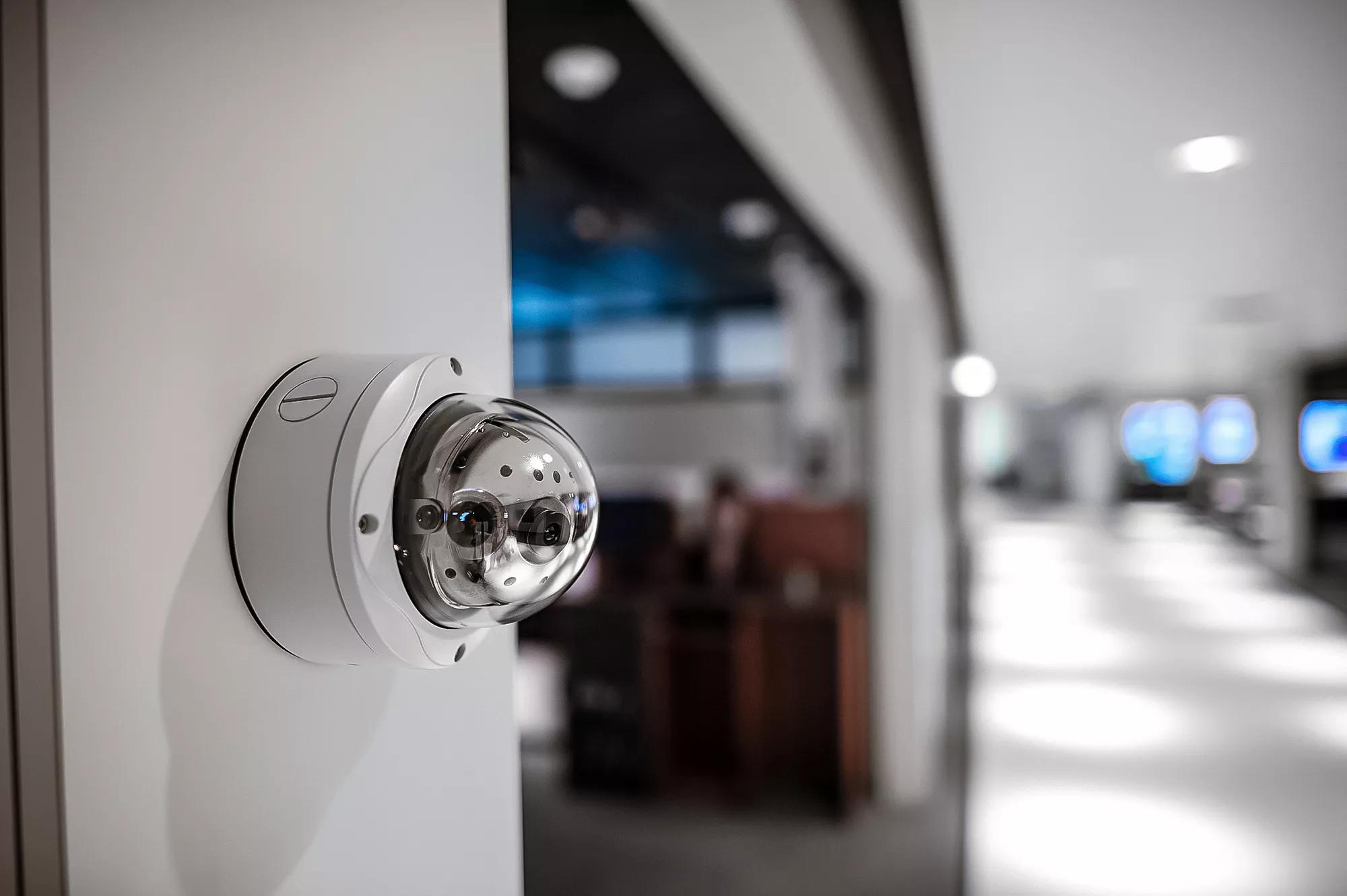Video Surveillance Cameras: Should You Choose Analog or IP?

Video Surveillance Cameras: What you should know when considering analog or IP
Analog cameras are more familiar and have a more linear mode of operation than IP cameras. IP cameras operate through the Internet Protocol—a set of rules governing data transmission from one computer to another. This type of camera typically has multiple functionalities.
When you’re deliberating which option is best for an organization, you may think an IP camera would be the obvious choice. After all, they are digital, and many experts consider them the future of enterprise security camera systems, depending on your organization’s size and security needs.
Analog camera solutions and their advantages
Analog cameras are the traditional cameras you see in camera systems. They record images to a video recorder and send them through a coaxial cable to a Digital Video Recorder (DVR).
There are different types of analog cameras. These include:
-
Bullet cameras
-
Dome cameras
-
Box cameras
Analog systems offer many advantages. One of the biggest is their cost; they tend to be significantly cheaper than IP cameras, especially as their camera count increases. Familiarity is another plus; they’re easily recognizable and findable. Since they’re so common, you may have an easier time finding vendors and installers. Their presence alone assures your organization that you’re secure, and let intruders know you have a line of defense.
Simplicity is another major benefit of analog cameras. They are fairly easy to run, as are DVRs. Additionally, technology for analog cameras has evolved. “High definition (HD) analog has tremendously increased the picture quality and the resolution. You can get four and five-megapixel cameras that are HD analog, and that’s impressive,” says Tim Sutton, director of security at GHG Management, to SecurityMagazine.com.
The cons of using analog cameras for video surveillance
Compared to an IP camera, you may not get the most optimal quality images. Analog cameras have lower frame rates, which makes it hard to see images in high detail or those with a lot of motion. The images aren’t as sharp and they may be grainy or blurry. Analog cameras also don’t have the same zooming capabilities that IP cameras do.
Another dilemma is how much coverage an analog camera can offer. It may take three or four cameras to cover an area that one IP camera can. DVR-based technology also requires point-to-point connection and cabling. You also need more cables—a power cable plus a DVR cable—to fully operate them.
Additionally, analog cameras don’t offer encryption. This means that a hacker could potentially access your information or replace your signal with an outside one.
The benefits of IP video surveillance systems and NVRs
IP video surveillance systems use an IP network, rather than cabling setups, as the conduit for delivering information. They send data over the internet or local area network to a network video recorder (NVR). This happens through Power over Ethernet (POE)—a device with multiple ethernet ports that provides power and communication to IP cameras.
At a basic level, NVR is a software program that records your video footage in a digital format like a hard drive, USB, or storage device. This means you don’t need a complex, boxy setup with multiple ports. You can run an NVR on a device that’s capable of running the program. Additionally, you can view the footage remotely using a computer or in some cases, other devices.
IP cameras offer a wealth of benefits. First, these types of cameras can provide better image qualities than their analog counterparts. How? They have features like progressive scanning and megapixel sensoring. You can get cameras with different resolutions and aspect ratios customized to your needs. A single IP camera can cover an area that several analog surveillance cameras can.
Second, IP cameras can save you money in the following ways:
-
You can save 50 to 60 percent of costs by using network cables. The cabling for analog cameras is more complex, involving coaxial cables, PTZ control wires, audio wires, and power cables. One network cable streamlines operations.
-
Today’s IP camera solutions also cost significantly less than they used to.
-
IoT has made these cameras popular as there’s more demand for interconnected security. Due to their ubiquity, you have plenty of budget-friendly options to choose from.
Two other benefits are their flexibility and convenience. You don’t need to directly connect recording devices to the cameras. You can place your cameras at any point in the facility that is close to the network. NVRs and virtual matrix software can operate in an area you designate, not just at the end of a coaxial cable. Secondly, IP cameras don’t require a lot of equipment, whereas analog cameras require encoders or decoders.
In terms of analytics and encryption, IP cameras have many powerful capabilities. First, many of these cameras have encryption built-in, so your data remains safe from the beginning. Secondly, IP cameras can sense when something disappears and set off alarms. They’re able to track certain colors, detect motion or smoke, count people, or flag unwanted individuals. High-performing solutions will have ways to monitor patterns and provide easy ways to report the data.
The challenges of working with IP video surveillance systems
Even though IP surveillance systems may seem new and exciting, they have their pain points as well. Since it’s a new technology requiring higher technical skill levels, IP video requires trained installers. Finding skilled technicians is an ongoing challenge.
There’s also a learning curve to use this type of camera. You’ll need to know and train end-users and system integrators on the technicality required. Secondly, the initial set-up of an IP camera may be costly. However, you could make the case that you save money in the end because it’ll be easier to scale and adjust your systems.
Other disadvantages are:
-
Storage and bandwidth requirements: IP cameras generate larger files than analog cameras because they have higher-resolution. This means they require more bandwidth, and the video quality is dependent on your network bandwidth. Therefore, you’ll want to adjust your storage space accordingly and plan for bandwidth levels.
-
Threat vulnerability: IP-based systems have diverse technologies and portals. These include VPNs, gateways, multiple servers, WiFi, access control systems, says MDPI research. This means more complexity and a much larger attack surface. IP cameras in particular have a target of distributed denial of attacks (DDoS). They’ve been exploited to invade users’ privacy and even mine cryptocurrency.
However, it doesn’t mean that they’re insecure technologies. The security of an IP camera largely depends on its level of data encryption and network security.
-
Potential for oversight: If you don’t make the right choices for your IP security camera provider, it may be more expensive than analog cameras. For example, if you don’t keep track of your IP Camera recording system license costs, they’ll cost far more than embedding recording system alternatives would have.
-
Scalability: Generally, NVRs are built with a specific purpose for each location. Adding additional cameras to the network may be challenging or unfeasible.
What environments are best for IP and analog cameras?
The context will determine how effective your enterprise security camera system choices will be. Consider the size of your organization. If you’re an organization that requires more than 32 cameras, consider IP cameras. When you factor in installation, cabling, storage, and video management, IP cameras may be less expensive. This type of camera is best if you require performing multiple security activities at once, like monitoring, remote viewing, and operational capabilities.
Some of the business environments and verticals where IP cameras are common are:
-
Larger enterprises
-
Education
-
Transportation
-
Government
-
Retail
-
Hospitals
-
Distributor companies
-
City-wide surveillance
Analog cameras may be a better choice for smaller businesses (specifically retail) and single-location end users. A DVR may be sufficient for their needs. They may also be easier to install and uninstall than digital options. Interestingly, experts consider casinos a viable setting for analog cameras. Casinos can’t tolerate any delays in-camera control or image display. Analog cameras provide real-time surveillance and hardware-based control.
Are hybrid systems the best of both worlds?
When you’re making sense of your video surveillance storage options, choosing between analog and IP systems isn’t always cut-and-dry. Consequently, hybrid systems are steadily rising in popularity. As you’ve probably assumed, a hybrid security system allows you to record both analog and IP security cameras. It will transmit the recordings through a hybrid video recorder (HVR).
An HVR can interconnect your analog cameras and your IP cameras. They can expand and integrate different cameras and bridge the gap between legacy technology and IP technology. They are also helpful with remote monitoring and can support higher resolution cameras (1080p or greater). Today’s innovative models will let you operate them through a mobile app.
Of course, HVRs have their challenges as well. First, this technology requires a larger equipment footprint than DVRs and may cost more. They also have less processing power than an NVR. Additionally, they can only support a small subset of IP cameras, and can’t support a large number of high megapixel IP cameras. This makes the technology difficult to scale.
What are my other options for security camera systems?
Aside from DVR, NVR, and HVR, you can also use video management software systems (VMS). VMS helps you leverage the capabilities of both analog and IP cameras. With analog cameras, use video encoders to integrate them and combine them with the functionalities of IP cameras.
VMS systems also enable you to watch both past and present happenings at the same time. Many software options allow you to access a live video feed via the internet or a mobile app. Because of the software’s accessibility, you can use remote surveillance monitoring through a web browser or a client. The decentralized nature of VMS makes it easier to scale your security program.
Another benefit of software systems is analytics. You should be able to detect motion, facial recognition, or any hitches with your access control systems. You can also see if there are missing objects or if someone physically tampered with a camera.
Like any software program, a VMS has a learning curve. This is a more robust expansive system and therefore can have a complex user interface. They may also cost more. However, if you want to keep adding cameras to your network and continue accessing analytics, a VMS may be the best option for your organization.
Points of consideration when you’re researching video surveillance camera solutions
First, contemplate the surveillance cameras that are best for your specific organization. With IP cameras, it’s easy to get caught up in “shiny new object syndrome” and be dazzled by all it can offer. However, you may not need the extra features and capabilities.
Ask yourself:
-
What do we really need?
-
What’s a realistic budget?
-
Does the vendor we’re talking to right now understand the technology and our network needs?
-
Do they have experience with our industry?
-
Does this investment align with our overall security goals?
-
Will we be able to adjust this solution as our business grows?
If you need to elevate your security, but are budget-conscious, experts like Sutton recommend starting with replacing a few cameras at a time. Replace the analogs that are the most important and develop a plan to integrate more IP cameras. Build your security camera system for longevity and potential business growth.
Reap the benefits of different video surveillance systems?
Video surveillance security isn’t one-size-fits-all. It’s true that IP-based cameras have more technical capabilities and more public praise. On the other hand, there are environments and situations where analog cameras will be enough, or even the better choice.
Want the best of both worlds? Consider solutions that let you incorporate both camera types and scale along with your business.
Look into options where you can integrate and streamline multiple solutions into one system to maximize its performance. When it comes to video surveillance, you need to use every advantage you can to protect your organization. Luckily, today there are many solutions for video surveillance cameras that allow you to do exactly that.
Disclaimer: By using the Blog section of this website (“Blog”), you agree to the terms of this Disclaimer, including but not limited to the terms of use and our privacy policy. The information provided on this Blog is for information purposes only. Such information is not intended to provide advice on your specific security needs nor to provide legal advice. If you would like to speak to a Security representative about your specific security needs, please contact us.























